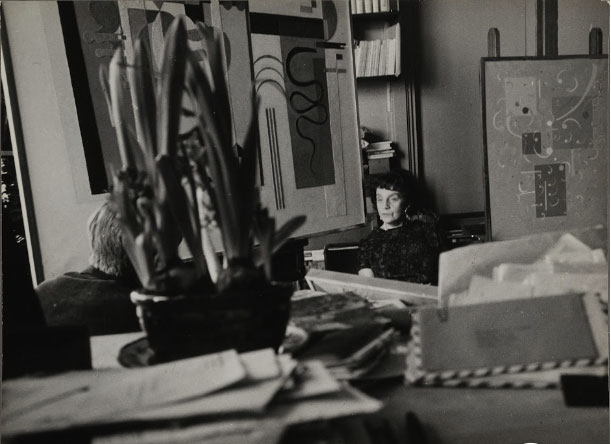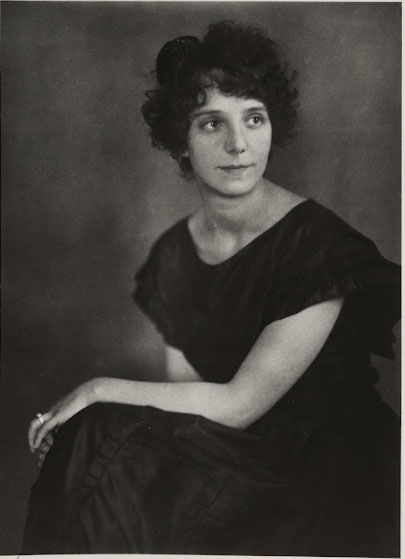|
After
Kandinsky's death
in 1944, Nina asked me,
as well as many others,
how to proceed with
carrying out
Kandinsky's last
will. Everyone knew
what was in his will:
he wanted his important
collection of several
hundred paintings to be
donated "to the
Russian people."
Along with everyone in
the West, knowing
Russia I answered:
"His paintings
will simply end up in
the museum storage
depots, hidden from
'the
people.'"
Nina's answer:
"He knew that, but
he was sure it
wouldn't last
forever." In point
of fact, it
wouldn't be until
nine years after
Nina's own death,
in 1989, that a large
Kandinsky exhibition
was finally organized
in Moscow, and then
also traveled to
Germany, where it was
shown in the renowned
Schirn Kunsthalle in
Frankfurt. But at the
time, Nina continued:
"I've already
been to the embassy and
even to Moscow to
discuss the matter.
They are nice to me:
they send me caviar and
other good
things."
So Nina wasn't
spoiled only by Moscow,
but also by Germany,
where she was not only
honored by a Medal of
Merit. The German
embassy held a formal
event honoring
Nina. Munich's
museum director, Hans
Roethel, could
not—or did not
want to—attend,
so he sent me in his
place. At the event,
there was a very long,
very fine, lunch table
attended by French
cultural high society
eating a luxurious meal
of leg of lamb,
Nina’s
favorite…
Incidentally, it was
here that I got to
know, to respect and
even to love
Nina’s best
friend, the
Ukrainian-Jewish Dina
Vierny. Just look at
her book about her
adventurous life as
Maillot’s model,
soon the friend of all
French avant-garde
artists, then active in
the French resistance
against the German
occupation, and more!
And in addition to
Germany's official
special treatment of
Nina, Roethel
personally introduced
her to a cultured,
younger art collector
and jeweler, the
handsome Max Pollinger,
who kept inviting her
to cabarets and so
on—to the kinds
of things she had been
missing during her
married life.
But it was France that
surpassed them all: in
the first place, Madame
Claude Pompidou, wife
of France's prime
minister, then
president, became
Nina's "best
friend" (a fact
she could not stop
talking about with
great pride). Added to
this, younger, more or
less cultured men kept
inviting her to picnics
in the Alps, and the
like. About this,
gallerist Karl Flinker
for some reason found
it necessary to explain
to me that these
excursions were
"harmless, just a
little flirting,"
although I knew nothing
about it from Nina
herself and
couldn't have cared
less. Just as I,
although often invited,
cannot confirm her
reputation for
"drinking even men
under the table."

Nina Kandinsky in her husband's studio in Neuilly-sur-Seine, c. 1980.
Photo by Vera Spoerri
Her will was in favor of France! After the large, 1989 one-man Kandinsky
show in Moscow and Frankfurt, Nina made Moscow a gift of three
paintings: One work from his Paris period went to the Tretyakov Gallery;
two from his Bauhaus period went to the Pushkin Museum. Would she
have changed her mind, remembering Kandinsky's will?
There is no way of knowing: Nina Kandinsky was strangled in her
bathroom in Gstaad soon after that, in 1980! This was hardly mentioned by
the French press. None of Kandinsky's paintings were missing. This is good
because, like most artists, Kandinsky had kept his best works of every
period "for himself," as a bequest to Nina, who would surely survive him.
Instead, around 400 paintings, watercolors, books and manuscripts
became the possession of the French State, ending up in the new Centre
Georges Pompidou, where of course only a small number of Kandinsky's
works could be shown, even if, from time to time, they were alternated.
Nina's money, more than a million Francs, went to the Société Kandinsky,
where it was well used for publishing catalogues raisonnées and other
scientific works.
For some reason, a close friend of Madame Pompidou's, my Swiss
publisher, found it necessary to warn me: "One should not talk too much
about the tragic murder. The culprit is already in prison after trying to sell
the stolen jewelry; it was a Russian relative who knew that he would not
inherit anything from Nina." This was a lie: there was no relative, nobody
went to prison, and the murder was never elucidated. Years later, a
questionnaire was sent to all of us, asking if we knew of any Russian
relatives. Result: No. A lady journalist thoroughly investigated, but the
Swiss police confirmed that the case could not be solved. She published her
article: "Wer ermordete Nina Kandinsky?" ["Who Murdered Nina
Kandinsky?"] It did not seem to interest many people. So I would like to
mention it now, because it should not be forgotten.

Portrait of Nina in Weimar, 1922. By Lüttich Demler
Conclusion
In her book and her conversations, Nina insisted that the much older
Kandinsky was "her prince, her destiny." Convincing, since her father had
died in the Russo-Japanese war in 1905, when she was seven years old.
Here it is interesting to note that, out of vanity, Nina had made everyone
believe she was born in 1899, and this is the date repeated in the scholarly
literature everywhere. But after her death, it was learned that she was born
in 1893. This means that she had waited till the age of 24 for a 50-year old
man, at a time when 18 would have been the normal age for marriage…
From Kandinsky’s side—and here I risk annoying some feminists—he did
have a keen sense of beauty, enjoyed in part by living with a much younger
woman. And Nina was certainly an extraordinary beauty—elegant and
refined. When he met Nina, he wrote to his longtime partner, the gifted
painter Gabriele Münter (also quite a bit younger than he was) that he had
finally found the state of mind needed to paint the important picture he
had craved for a very long time, "the meaning of which would be joy, the
happiness of life, or of the universe." But he did not dare to mention the
reason, only that he would have obligations in Moscow, and that there
would be "nothing disagreeable" about them.
|